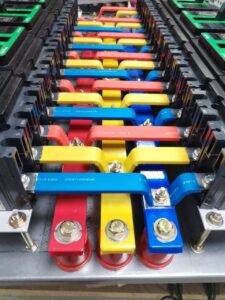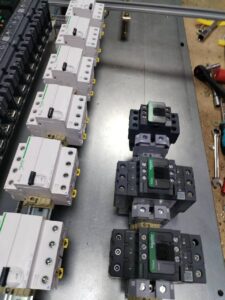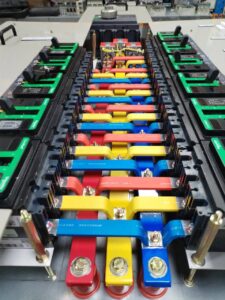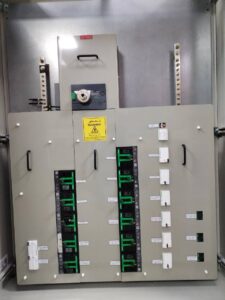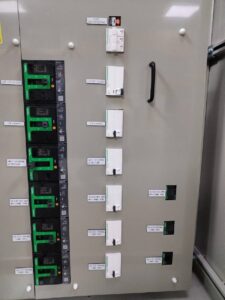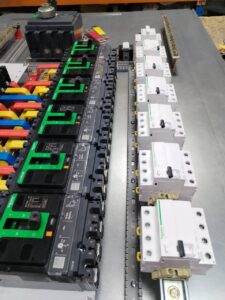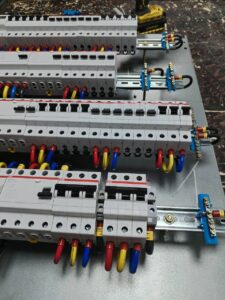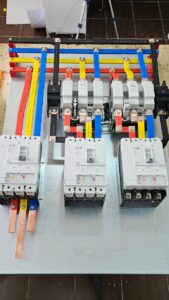High Voltage Insulation Testing
High Voltage Insulation Tester:
An insulation tester, also known as a megger, is an electrical instrument used to measure the electrical insulation resistance between two conductors or between a conductor and ground. The device applies a high DC voltage (typically ranging from 100 volts to 10,000 volts or more) to the insulation to be tested and measures the resulting electrical current. Based on the voltage and current values, the device calculates and displays the insulation resistance.
Basic Components of an Insulation Tester:
1. High-voltage DC source: To provide the voltage required for the insulation test.
2. Ammeter: To measure the leakage current through the insulation.
3. Resistance calculation circuit: To calculate the insulation resistance value based on the voltage and current.
4. Display screen: To display the insulation resistance value, voltage, and current applied.
5. Terminals: To connect the device to the electrical component to be tested.
6. Control switches: To set the test voltage, measurement range, and on/off the device.
How Does an Insulation Tester Work?
When an insulation tester is connected to an electrical circuit or device and the test voltage is applied, a very small electrical current will pass through the insulation. The higher the insulation resistance, the lower the leakage current, indicating good insulation quality. Conversely, a low insulation resistance indicates weak or damaged insulation, which could lead to electrical leakage or a short circuit.
Importance of Insulation Testing and Its Use in Various Applications:
Insulation testing is a critical preventative and diagnostic procedure for ensuring the safety and reliability of electrical systems and equipment. Here are its most important uses in various fields:
• Transformers:
• Importance: Ensures the integrity of the insulation between the transformer windings (primary and secondary) and between the windings and the transformer’s metal body. It helps in early detection of any insulation weaknesses caused by moisture, contamination, or thermal deterioration, preventing serious faults and short circuits that could lead to complete transformer failure or fires.
• Benefit: Extends the operational life of the transformer, avoids costly downtime for repair or replacement, and ensures the safe operation of the electrical system supplied by the transformer.
• Cables:
• Importance: Checks the integrity of the insulation surrounding the cable’s electrical conductors. Detects any damage to the insulation resulting from cutting, friction, exposure to chemicals, or moisture.
• Benefit: Prevents electrical shorts between conductors or between conductors and ground, reduces the risk of electric shock, and ensures efficient power transmission without significant leakage loss.
• Electric Motors and Generators:
• Importance: Evaluates the insulation condition in motor or generator windings. Detects any insulation deterioration due to excessive heat, vibration, contamination, or moisture.
• Benefit: Prevents short circuits within the motor or generator, avoids costly winding damage that requires repair, and ensures reliable operation of equipment powered by these motors and generators.
• Electrical Distribution Boards:
• Importance: Checks the integrity of the insulation between the various components within the panel (breakers, switches, busbars) and between these components and the panel structure.
• Benefit: Prevents short circuits within the panel, reduces the risk of fire, and ensures safe and reliable operation of the power distribution system.
• Household and Industrial Electrical Appliances and Equipment:
• Importance: Ensures the integrity of insulation in various appliances and equipment to protect users from the risk of electrical shock.
• Benefit: Provides a safe work and home environment, reduces electrocution accidents, and ensures efficient operation of appliances.
Disadvantages of Not Using Insulation Testing:
Failure to perform insulation testing regularly and regularly can lead to serious consequences, including:
• Increased risk of sudden electrical failures: Undetected poor insulation can cause a short circuit at any moment, causing equipment and systems to shut down.
• Increased risk of electrical shock: Deteriorating insulation can cause electrical current to leak into exposed metal parts, exposing personnel to the risk of fatal electrical shock.
• Increased risk of fires: A short circuit caused by poor insulation can cause significant overheating and fires.
• Damage to electrical equipment: Failure to detect insulation problems early can exacerbate them and cause significant damage to electrical equipment, necessitating costly repairs or complete replacement.
• Unplanned downtime: Sudden electrical failures can interrupt production processes or services, causing significant financial losses.
• Noncompliance with standards and regulations: Many electrical standards and regulations require periodic insulation testing to ensure safety and reliability. Failure to comply with these requirements may expose companies to legal liability.
Mavericks and Insulation Testing Services:
As Mavericks, you can rely on them to provide:
• High-quality insulation testing equipment: Mavericks likely offers a variety of insulation testing equipment (meggers) suitable for various applications and voltage requirements.
• Specialized and trained technicians: Mavericks’ team must have the experience and knowledge to perform insulation tests correctly and safely and interpret the results accurately.
• Comprehensive testing services: Their services may include conducting on-site tests, providing detailed reports on the insulation condition, and providing recommendations for corrective action if necessary.
• Compliance with standards: It is important that Mavericks adheres to local and international electrical standards and regulations when conducting insulation tests.
When working with Mavericks, you can inquire about:
• The types of insulation testing equipment they offer and their specifications.
• The experience and qualifications of their technicians.
• The procedures they follow for insulation testing.
• The reports they provide after testing.
• The cost of the service and available timelines.
